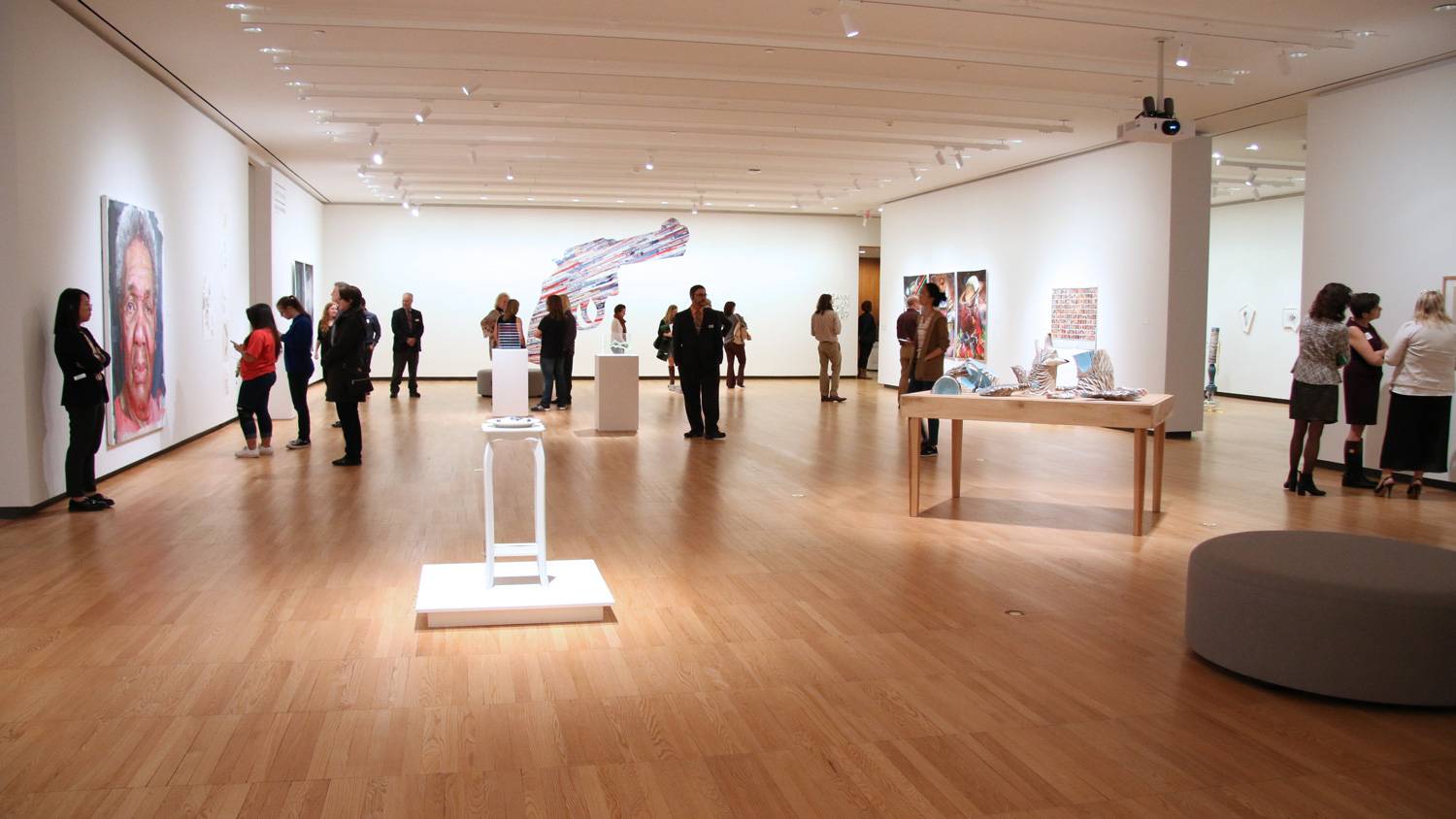On November 17th, this year’s School of Art + Design Faculty Exhibition opened in the Krannert Art Museum’s newly renovated main floor galleries. This yearly exhibition features over twenty current pieces by faculty teaching in the School of Art + Design. The artwork represents a broad range of teaching disciplines, including painting, printmaking, ceramics, sculpture, photography, metals, new media, graphic design and industrial design. Whether you love afrofuturist digital collage or plexiglass sculptures based on visualized data, there is something for everybody.
I had the spacious gallery all to myself on the Saturday of Thanksgiving break. In order to leave some mystery for the reader, this article will focus on some of these talented artists and teachers and leave others out. The exhibition will close on December 22nd for winter break, so if you haven’t had a chance to go yet, hopefully you will be enticed to make it there in the next two weeks.
A couple of the pieces made bold political statements. Chris Kienke’s “Bang Bang,” which covers one whole wall of the gallery space, is a huge sticker collage in the shape of a gun. On closer examination, the stickers — in long strips of red, white, and blue — appear to be cut from blown up TV news stills. Another notable piece is Nekita Thomas’s “Cultural Gym #2: Don’t Drink the Kool-Aid,” which is comprised of four prints that mimic iconic Chicago grocery store signage, remixing the messages to counter stereotypical images of blackness found in consumer retail. I was happy to recognize these signs. Steven Hudson replaced his original choice, a commentary on environmental catastrophe titled “Discovery,” with a darker painting to reflect the post-election climate. “Superweapon,” which dates from 1998, made in response to the political mood preceding the second Gulf War. It depicts grotesque, bloated human figures set in an apocalyptic wasteland.
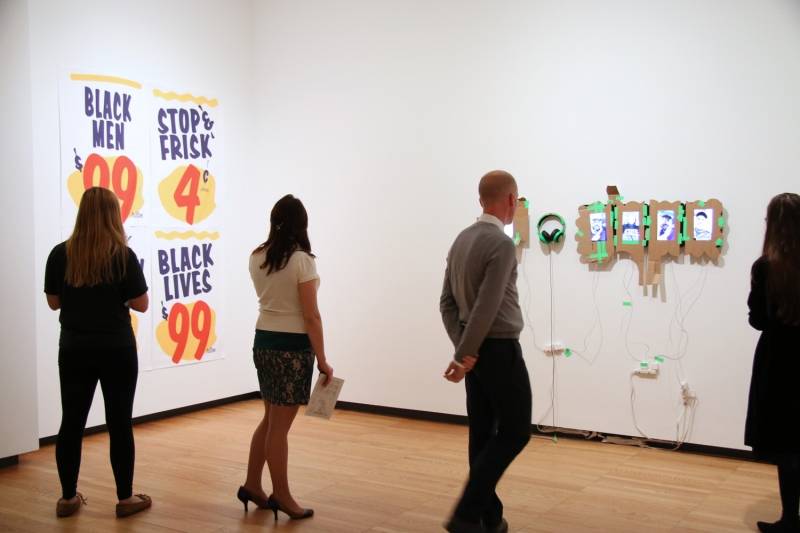
Many of the works were a pure joy to look at. Patrick Hammie’s large scale oil portrait, titled “F.B.J.,” leaps off the canvas in stunning pinks and blues. Joseph Squier’s “am” is a large photo collage in blue tones, with a pale, mottled hand and face emerging from the layered gloom. Rachele Riley’s “Beauty Piece” is a collection of charming printed cards reading “This is beautiful” in different fonts, for the owner to leave wherever he or she finds beauty in everyday life. Whoever finds the card is then invited to see the world through the eyes of whoever left the card. While some of the art was more pessimistic, I appreciated “Beauty Piece’s” simple celebration of personal discovery.
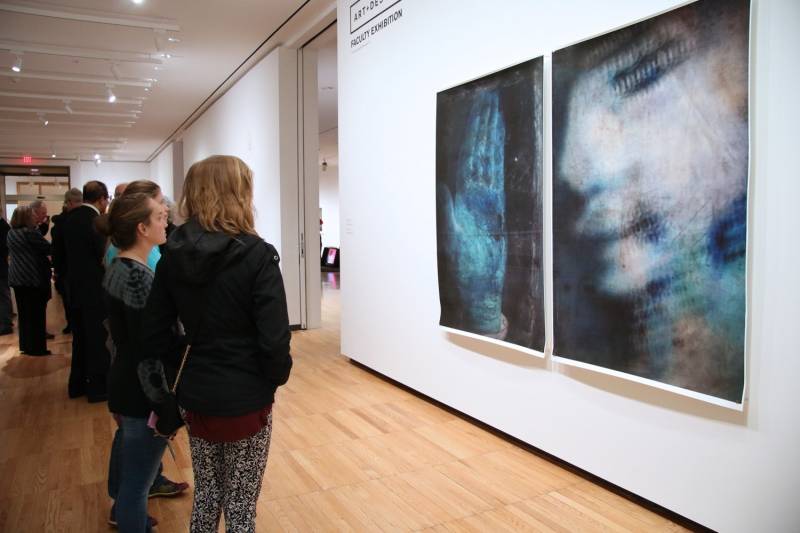
I particularly enjoyed the sculptures and installations, several of which had a whimsical feel. A favorite was Emmy Lingscheit’s “Cannis Latrans Subdivision,” made of cast vitreous china and glaze. The sculpture is a life-sized wolf in (by my count) eighteen neatly severed pieces — head, torso, paws, tail etc — implying both butchering and “some assembly required.” It has the cartoonish, airbrushed look of a plastic toy manufactured in the 1950s. The wolf’s insides are a smooth robin’s egg blue. According to Lingscheit’s website, much of her work explores “the alarming pace of species extinction worldwide.” “Cannis Latrans” is a departure from her printmaking background.
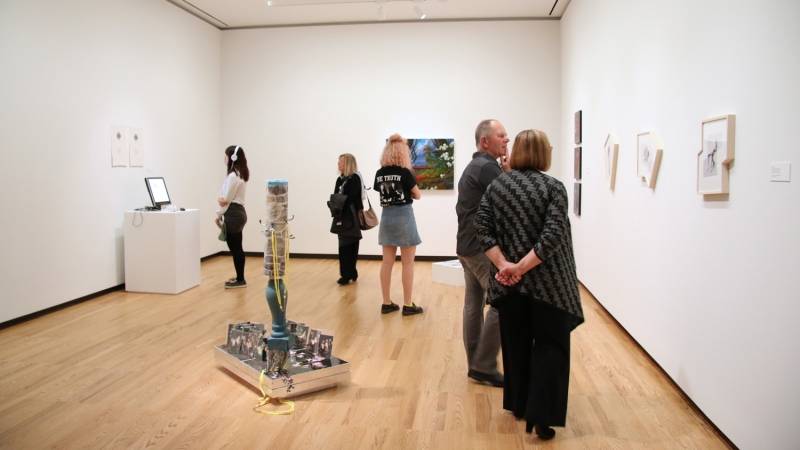
Another outstanding sculptural piece was Conrad Bakker’s “Untitled project: Still Life/Style Leaf.” The piece is composed of a collection of life-size, realistic items carved out of wood, giving it a Wes Anderson-ish dollhouse feel. On the wall, a “Minerals of the World” poster with minerals abstracted into blurry fractal shapes and colors, complete with an “Elsevier” logo at the corner. In an Amazon box underneath the poster, a collection of knick knacks including a bottle of extra strength excedrin, a potted cactus, an envelope from Artforum, and a copy of Jorge Luis Borge’s Labyrinths. The title of another book is obscured. The piece includes a slightly tweaked version of the poster and box on the opposite side of the wall, in another room. The whole thing reminded me of a partially remembered time in the artist’s life, manifested through everyday objects.
My favorite piece was an installation by Laurie Hogin, whose work of the past 20 years has “consisted primarily of allegorical paintings of mutant plants and animals in languishing, overgrown landscape settings or posed as though for classical still life or portraiture.” The four paintings in her corner of the gallery did not disappoint. Beneath the paintings, there is a miniature armchair upholstered in what looks like pepto-bismol pink animal fur, and a coffee table with several copies of a short story called “Hidden Boy,” published in the Spring 2016 issue of The Account: A Journal of Poetry, Prose, and Thought. The journal’s banner features one of Hogin’s pink guinea pigs peering through the “O” in “Account” with one menacing blue eye.
You are invited to sit in the chair and read the story. “Hidden Boy” is a magical-realism tale told from the point of view of a stodgy art professor living in the last days of a major University’s art department besieged by threats from an increasingly STEM-oriented administration, and firmly entrenched in the myopic practices of the fine art institution. The story centers on the haunting presence of a new student, who the professor names “Hidden Boy” because of his elusive nature and tendency to blend in with his studio space. It culminates in Hidden Boy’s final project. I won’t give more away: I will say that when I sat down in the pink chair, I was not expecting the uncanny, heebie-jeebie inducing experience that followed (maybe I was just in the mood to be spooked). But the story includes a sincere artist’s statement from Hogin about rediscovering her love for the narrative form and encouraging students to stay true to their instincts.
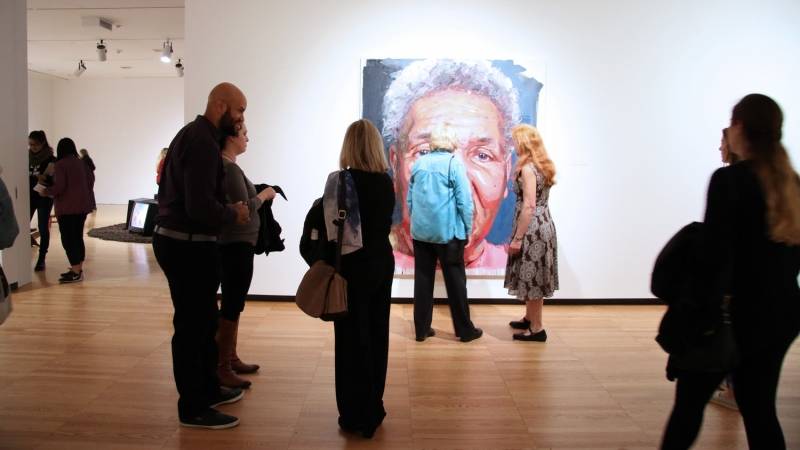
So go to the Krannert Gallery, sit in the pink chair, use the 1950s fat melting jiggle machine that didn’t make it into this write-up if you dare. Find out which pieces speak to you. The exhibition is open until December 22.
[editor’s note: an earlier version of this story incorrectly identified Joseph Squier’s piece as being titled “A.M.” Per the artist’s request, we have corrected the title to read “am”]








